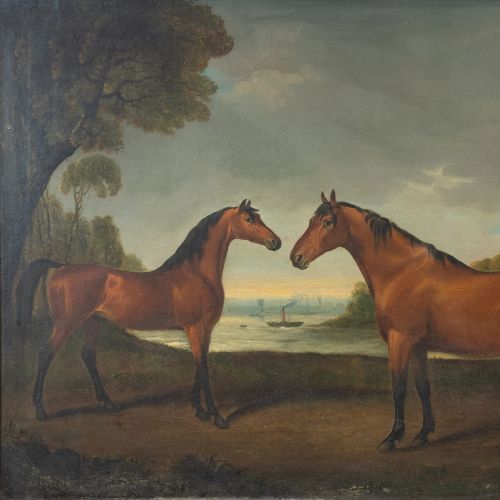A collection of antique textiles and costume from Barra Castle, Aberdeenshire, will be offered in Tennants Auctioneers’ Fashion, Costume and Textiles Sale on 22nd November. Comprising over 70 lots of curtains, antique costume, bed covers, lace, lengths of fine quality wool tartans, embroidered panels, Eastern textiles and more, the collection comes from the estate of Robert Bogdan, who, through his mother, was descended from the Aberdeenshire Lairds of Drum, Kemnay, Straloch and Barra, and for nearly four decades the Bogdan family lived in Barra Castle in Aberdeenshire.
Highlights of the collection include a Pair of William Morris ‘Tulip and Rose’ Pattern Curtains (estimate: £1,200-1,800 (all figures exclude buyer’s premium). ‘Tulip and Rose’ was an early design by Morris, first registered in 1876 and woven by the Yorkshire Heckmondwicke Furnishing Company before being exhibited in The Great Exhibition. Also of interest is a rare pair of 18th or 19th Century Palampore Decorative Printed Curtains, depicting fish, serpents, stylised peacocks and birds within a floral garland (estimate: £1,200-1,800). An 18th Century Floral Embroidered Bed Cover, with a central rounded depicting and exotic bird is offered with an estimate of £500-800, and a 19th Century Embroidered Ancient Royal Arms of Scotland with the motto of the Royal Stuart dynasty and the national motto of Scotland is offered with an estimate of £300-500.
ROBERT BOGDAN: A BIOGRAPHY
Robert Bogdan (1950-2023), who in 2019 became the chairman of the Scottish Castles Association, loved nothing better in his retirement than to scramble over the wilder parts of Scotland looking for castle ruins and Scottish tower houses.
As chairman of the Scottish Castles Association, Robert was able to indulge his love of the history and heritage of Scotland. When his brother, the archaeologist Nicholas Bogdan, died in 2002, Robert took up his efforts to update David MacGibbon and Thomas Ross’s work on the Castellated and Domestic Architecture of Scotland and set himself a challenge to visit as many castles and castle ruins as possible. His own family connections to the Burnett, Ramsay, Forbes and Irvine families gave him a great starting point, and his knowledge and enthusiasm opened many doors.
Robert was born in 1950 in London to paediatrician Andrew Bogdanovitch, who was smuggled as a baby out of Archangel in northwest Russia during the revolution and emigrated to London. He later met Robert’s mother Mary Irvine, known as Mhairi, when she was the commandant of the naval hospital on the Isle of Man during the Second World War. In the year that Robert was born the family changed their name from Bogdanovitch to Bogdan.
Robert was educated at Terrington Hall, North Yorkshire, and Gordonstoun, Moray, where he excelled at tennis, hockey and cricket. He was a member of the team immortalised in the William Boyd novel ‘Dutch Girls, which was subsequently made into a film, about a group of schoolboys on a hockey tour in the Netherlands. He embraced the outdoors and the extra-curricular activities for which the school is famous. He went on to read medieval history and geography at the University of St Andrews and represented the Scottish universities at hockey, before undertaking a PGCE at St Catharine’s College, Cambridge, where he earned a hockey blue. For many years he played hockey all over the world for clubs including Surbiton, Hawks, the Travellers and Oxbridge Nomads. On the strength of his Cambridge blue, in 1975 Robert was approached to teach geography and run the hockey at Charterhouse, Surrey. He thought he might try it out for a year, but stayed for 40, retiring in 2015. Renowned for his kindness, hospitality and sense of fun, his pupils fell under the spell of his enthusiasms for geography, hockey and particularly Scottish reeling, which he founded at Charterhouse; the St Andrew’s Ball remains an annual event at the school.
From Barra Castle the view of the summit of Bennachie rises majestically, and in the early 80s Robert bought a cottage on its slopes, for he liked nothing better than to host his friends there, organising dinners and parties to attend the Aberdeenshire balls, or just to dance in his dining room. Indeed, Robert could never resist a party, particularly if it included dancing; he went reeling all over the world to venues including a Viking longhouse in Iceland, the Alhambra, a palace in Istanbul, a salt mine near Krakow and most recently the Palace of Versailles.
Welcoming, warm and colourful, his homes were a haven for animals, friends and newcomers alike. Robert loved nothing better than to tell stories of the quirky artefacts tucked away in chests and cupboards which had been accumulated by his Scottish or Russian ancestors. A pair of King of Nigeria’s enormous trousers and one shoe that he owned even found their way onto the Antiques Roadshow and were modelled by its presenter Fiona Bruce. Happy in full highland regalia in which he dressed immaculately, Robert’s friends probably knew him best wielding a chainsaw or building a wall. He loved all the people of Aberdeenshire.
Robert’s greatest gift was his love of, and loyalty to, people – and their love of him.
View Sale Details















